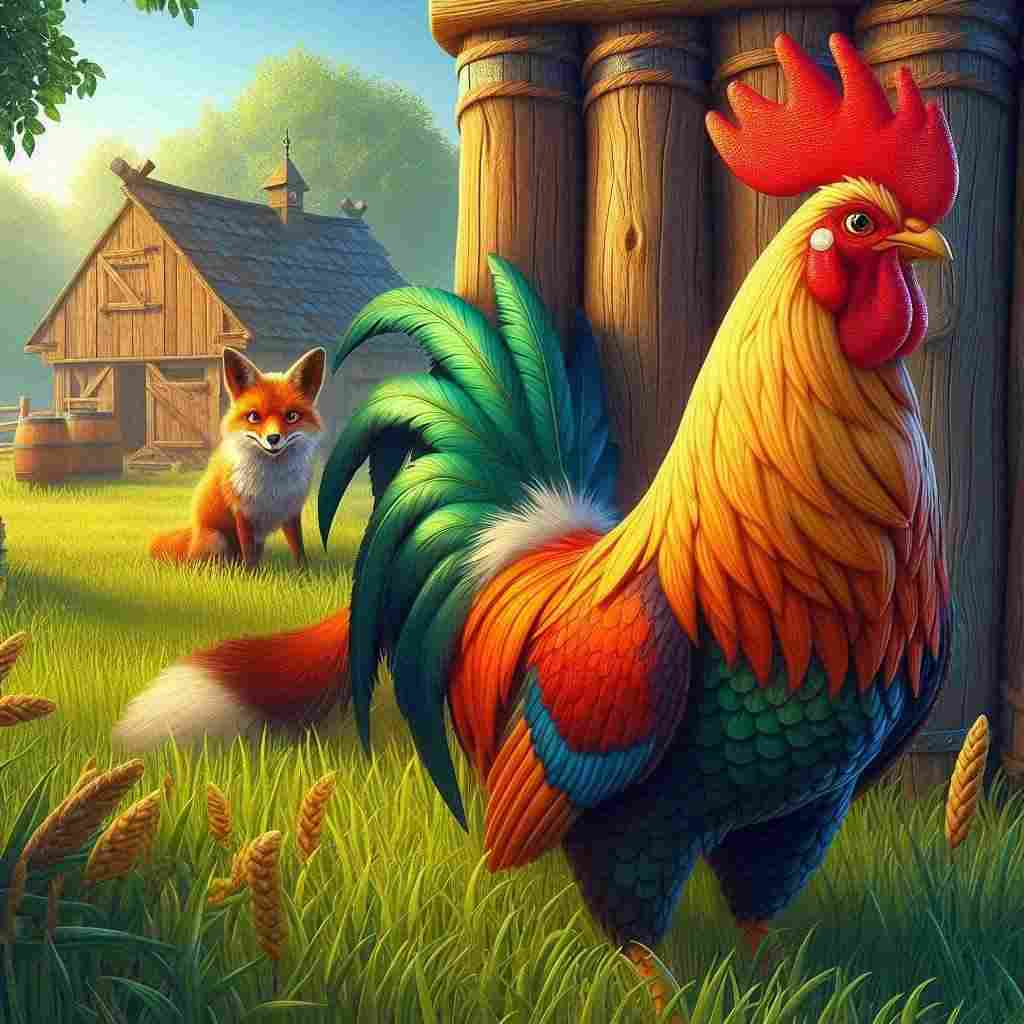The Nun's Priest's Tale
Richard

In a farmyard bright and gay,
Lived a rooster, Chanticleer,
With feathers bright and crow so clear,
He ruled the hens, day by day.
Oh, Chanticleer, the cock so bold,
In his coop, he was not cajoled,
Until one day, a fox appeared,
And the farmyard's peace was soon besmeared!
Reynard the fox, cunning and sly,
Watched Chanticleer with a hungry eye,
He flattered the cock, oh so sly,
With tales of dreams that soared so high.
Chanticleer, in his pride,
Closed his eyes, with the fox beside,
But in a flash, the fox did snap,
Caught the cock in a deadly trap.
Chanticleer, with a cry so shrill,
Called the hens, with all his will,
They chased the fox, away he fled,
With Chanticleer safe, but full of dread.
Now listen well, to this tale so gay,
Of Chanticleer and his fateful day,
Beware the flatterer, with words so fair,
For cunning foxes lurk everywhere!
So here ends our tale of the cock so fine,
And the fox who almost made him dine,
With laughter and mirth, let’s all agree,
The Nun's Priest's Tale, a joy to see!
Richard's The Nun's Priest's Tale
"The Nun's Priest's Tale" is a delightful adaptation of Geoffrey Chaucer's classic story from The Canterbury Tales, reimagined here as a whimsical song. This lyrical rendition captures the essence of the original tale while infusing it with a playful, musical quality that brings the story to life in a new and engaging way.
The song centers around Chanticleer, the proud and confident rooster who rules over the farmyard. The recurring refrain, "Oh, Chanticleer, the cock so bold, In his coop, he was not cajoled," emphasizes the rooster's initial invulnerability and sets up the dramatic irony of his eventual downfall. This repetition serves as a reminder of Chanticleer's character and the central conflict of the story.
The lyrics skillfully introduce the antagonist, Reynard the fox, describing him as "cunning and sly" with a "hungry eye." This characterization immediately establishes the tension between the two characters and foreshadows the impending conflict. The use of vivid imagery, such as the fox watching Chanticleer and flattering him with "tales of dreams that soared so high," paints a clear picture of the deception at play.
The turning point of the story is captured in a single, powerful stanza: "Chanticleer, in his pride, Closed his eyes, with the fox beside, But in a flash, the fox did snap, Caught the cock in a deadly trap." This moment encapsulates the central theme of the tale - the danger of pride and the vulnerability that comes with vanity. Chanticleer's downfall is swift and sudden, mirroring the original story's message about the perils of flattery and self-importance.
However, the song doesn't end with Chanticleer's capture. Instead, it continues to narrate his escape, adding a layer of excitement and a satisfying resolution to the tale. The line "They chased the fox, away he fled, With Chanticleer safe, but full of dread" shows the consequences of the rooster's ordeal and hints at the lesson he has learned.
The final verses of the song serve as both a conclusion to the story and a moral lesson for the listeners. The warning to "Beware the flatterer, with words so fair, For cunning foxes lurk everywhere!" extends the tale's meaning beyond the farmyard, applying it to human interactions and the broader world. This universality is part of what has made The Nun's Priest's Tale endure through the centuries.
Throughout the song, the use of rhyme and meter creates a bouncy, memorable quality that suits the folkloric nature of the story. The ABAB rhyme scheme and the consistent rhythm make the lyrics easy to follow and potentially sing along to, enhancing its appeal as a musical piece.
By adapting this classic tale into a song, the composer has made the story more accessible and entertaining for a modern audience. The musical format allows for repetition of key phrases and themes, reinforcing the moral of the story in a way that's both subtle and effective. The lighthearted tone of the lyrics, with phrases like "a joy to see" and the invitation to laugh and agree, creates a sense of communal storytelling that echoes the original context of The Canterbury Tales.
In essence, "The Nun's Priest's Tale" song manages to preserve the spirit and message of Chaucer's original while transforming it into a standalone piece of musical storytelling. It serves as a testament to the enduring power of classic literature and its ability to be reinterpreted and enjoyed in new forms across generations.
This text was generated by AI and is for reference only. Learn more
Want to join the discussion? Reopen or create a unique username to comment. No personal details required!



Comments
No comments yet. Be the first to comment!